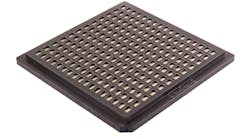Advances in materials have been the springboard to enhancements in higher-frequency circuits and higher-efficiency, more compact circuits. As an example, the use of composite right/left-handed (CRLH) metamaterial transmission lines has made possible a miniature multiple-band resonator with frequencies extending from 2.8 to 10.4 GHz and high selectivity between the resonant circuit structures. In addition, the resonant structures have closely matched return losses.
The multiple-band resonator is fabricated on standard commercial circuit material with dielectric constant of 3.55 and thickness of 1.52 mm. It consists of a CRLH unit cell plus an additional series-connected resonant circuit that tunes the overall structure and provides the third frequency band. The resonator measures just 16.5 × 18.9 mm2 and delivers the multiple frequencies and compact size required for many modern communications circuit designs.
The steady expansion of wireless functions creates the need for denser high-frequency circuitry in smaller circuit sizes. CRLH circuitry has been shown as an effective means of shrinking the size of planar microwave components,1 with even greater circuit density and miniaturization possible using dual (D-CRLH) circuit structures.2 The two types of circuit configurations have been employed as filters, duplexers, diplexers, couplers, and power dividers in much smaller sizers than possible with conventional microstrip and stripline high-frequency transmission-line circuitry.3-5
For multiple-frequency-band applications in communications systems, CRLH transmission-line (CRLH-TL) resonators offer numerous advantages over traditional TL resonators because they have three branches in a half-periodicity configuration.2 To enhance the bandwidth of the compact resonators, U-folded resonators3 and multimode resonators4-6 were developed, too.
Multiple-band resonators had been built previously, serving as a starting point for the current design,7 while stepped-impedance resonators were also developed to produce multiple frequency bands.8,9 Unfortunately, the performance of these multiple-band stepped-impedance resonators was limited and, to improve the spectral purity of these multiple-band resonators, the small size of the initial design was sacrificed for an improvement in performance. 10,11
The researchers’ current work consists of a new resonator structure in which a gap-coupled microstrip resonator optimizes the use of tuning an additional tuner with a CRLH cell. This achieved three resonant frequencies/bands with simple control of the center frequencies and bandwidths. By using the CRLH transmission line, resonator length can be decreased to less than one-quarter wavelength at each frequency of interest, while maintaining good spectral performance.








